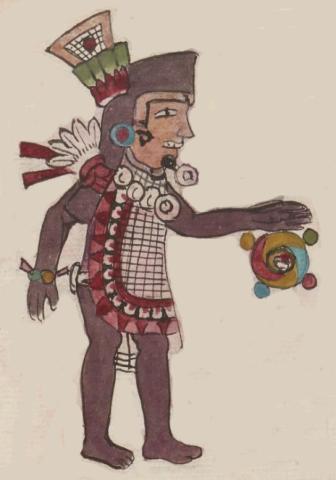huei tecuilhuitl (TR1v)
This iconographic example from the Telleriano-Remensis codex shows a human figure with a cloak and headdress (perhaps representing a tecuhtli, lord) standing and facing toward the viewer's right. Next to his outstretched (left) hand is the glyph for ilhuitl, day. We base our assessment of the glyph near his hand because of the gloss, which refers to this as a representation of the 20-day cycle "huei tecuilhuitl" in the divinatory calendar. The gloss contains both tecuhtli and ilhuitl, with the adverb referring to the veintena's greatness.
Stephanie Wood
vey tecuilvitl
huei tecuilhuitl
Stephanie Wood
ca. 1550–1563
Jeff Haskett-Wood
teuctli, diademas, diadems, crowns, coronas, señores, lords, teuctli

Huei Tecuilihuitl, a month of 20 days, relating to fe
tecuh(tli), lord, https://nahuatl.wired-humanities.org/content/tecuhtli
ilhui(tl), day, https://nahuatl.wired-humanities.org/content/ilhuitl
(nombre de un mes de veinte días que se trata de comida y sacrificios)
Stephanie Wood
Telleriano-Remensis Codex, folio 1 recto, MS Mexicain 385, Gallica digital collection, https://gallica.bnf.fr/ark:/12148/btv1b8458267s/f28.item.zoom
The non-commercial reuse of images from the Bibliothèque nationale de France is free as long as the user is in compliance with the legislation in force and provides the citation: “Source gallica.bnf.fr / Bibliothèque nationale de France” or “Source gallica.bnf.fr / BnF.”



